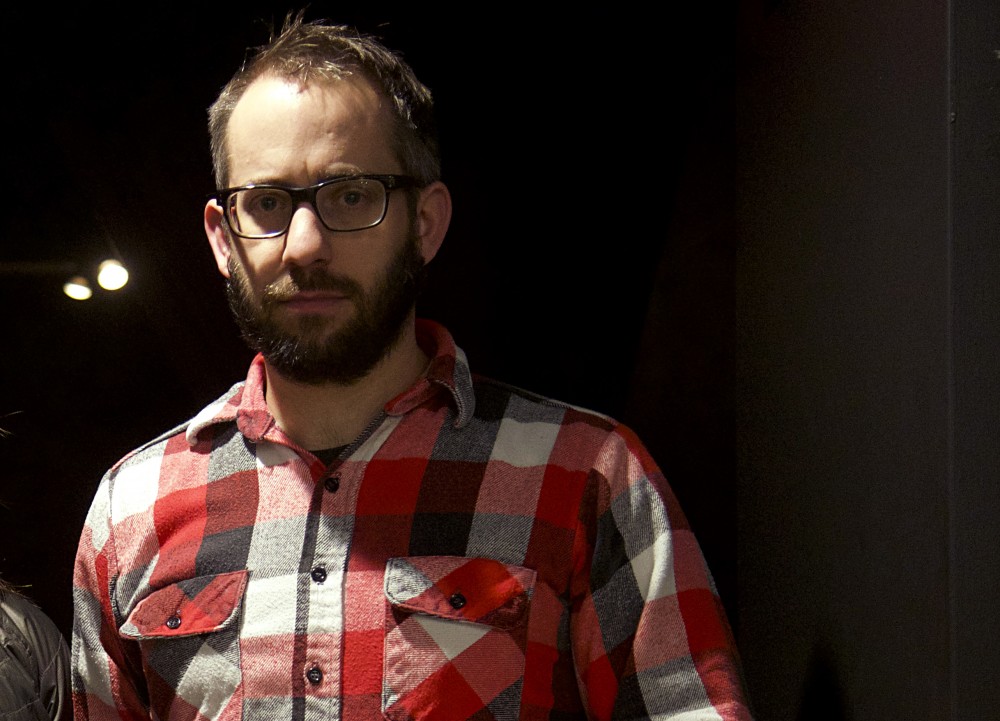Wednesday night, Trylon Cinema quickly sold out as University of Minnesota alumnus and adjunct professor Sam Hoolihan presented “Silence with Sound,” a collection of Super 8 and 16-mm films. The highlight of the evening was Hoolihan’s most recent work, “Stasis & Motion,” a 16-mm film consisting of three black and white projections, as well as live vocals and music by local artists John Marks and Crystal Myslajek.
A&E sat down with Hoolihan to discuss the collaborative project, as well as his past and present works.

Can you describe your work and yourself as an artist?
I started in the photographic arts, and then about six or seven years ago shifted to moving image work. I’m generally working with silent film right now. I use moving image to try to create a space for the viewer to slow down and be able to reflect, contemplate and meditate. I think it’s a reaction to how fast everything is moving in our contemporary media landscape… I like this idea where the tools that I choose, in this case the hand-cranked hand-processed film, forces me to slow down.
I’ve also started to work with some musicians and sound artists lately. [“Stasis & Motion”] is the newest film we premiered earlier this year at the Walker [Art Center] as a commission, which was a really wonderful experience for me.
It’s kind of hard to talk about my art practice. It’s mainly moving image and experimental. If you had to give it a title, I’d say lyrical, poetic, silent films, very inspired by music and painting more so than narrative cinema.
What about filmmaking was more appealing to you than photography?
I think the act of viewing and the cinema space as a very powerful, sacred space, meaning I think it’s one of our last spaces in our culture now where people give you this unwritten negotiation when they walk in … they’re going to be there and be present. In that sense, it retains that energy of a performance that’s live. It’s that power of the cinema space that I’m really attracted to.

When did you become interested in films and in filmmaking?
Probably like most people, growing up loving cinema … Movies always had this incredible power to me.
I never took [film] too seriously until I was feeling a little bored and apathetic about the world of photography when I was in grad school, and not feeling very engaged by it. All of a sudden, a professor at the U offered this Super 8 class, and I loved the challenge of the limitations that the technology had. I only had three minutes, it didn’t record sound, these cameras were really old and did weird things as they broke down and I just loved that aspect. Being able to project it, that light in a dark room was so soft and rhythmic. There’s something really hypnotic about it.
What was your experience like shooting and collaborating on “Stasis & Motion?”
[“Stasis and Motion”] was the third piece I’d done with John, and the second piece I’d done with John and Crystal. It’s a wonderful collaboration process, working with them. They challenge me. I think I challenge them. We have enough in common, but there’s some overlap where we’re different enough that it keeps it exciting and pulls us out of our comfort zones. I think that’s one of the main reasons that I do collaborations … every once in awhile, I feel a little stuck when I’m working by myself. So, if I’m collaborating with someone that pulls me out of my comfort zone and out of my bubble, it helps me grow.

That was a very organic process for “Stasis & Motion.” Crystal would play some recordings that she made in her studio to me and I would respond to those and go shoot, and then I would process the film. John would shoot some film, process it and we would show it together and make music to that … The projections are always going to be different sizes depending on the room we’re in. I’m always going to start the projectors at slightly different frames, so I like that it’s malleable and different every time. It’s like performance.
Are you currently working on anything new?
[At the screening] I showed an excerpt of a portrait of Minneapolis, “The City of Lakes,” and that’s an ongoing project. I’m doing more of multiple exposure in-camera stuff. That form and process has so many possibilities and I feel like I’m just taking baby-steps. I think there’s a lot of room for me to explore in that.
I’m starting to add more portraiture to my work too. I think I went very far into this almost nonrepresentational, slight abstract imagery. I went really deep into that and now I’m starting to come back to what I was doing in photography, which is more portraits.
What’s your biggest piece of advice for students interested in pursuing film?
I would say no matter what kind of medium you work in, I think [the Super 8 class] is a really healthy and exciting class for people to take. It forces you to use totally new tools and work with your hands in a different way… I would say dive in, buy a cheap, used camera that works and just start one roll at a time. That’s how I did it. I just focused on one roll to see what I could do with that three minutes… It forces a lot of discipline.
As far as shooting… I think people get really paralyzed at the beginning because they think they need to come up with this grand art concept or whatever, but I think just to get started and shoot what you love, shoot what you know, and then once that starts to roll you’ll start to move out from that. I think the most powerful films that I’ve seen that students have made have been very intimate and revealed a lot about themselves. They shot what’s in their daily life in a really beautiful, new way and those can be really poetic and powerful.

















